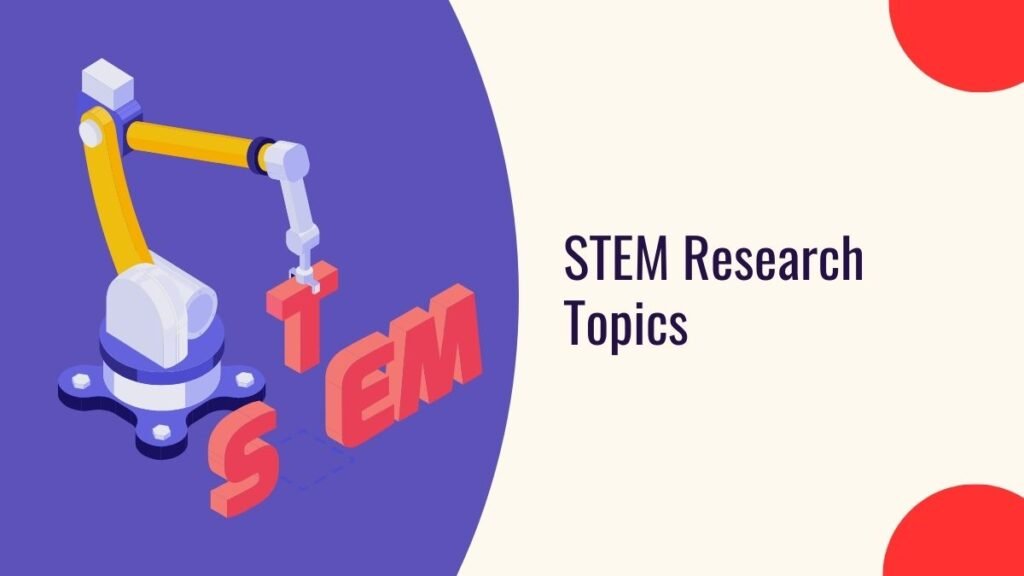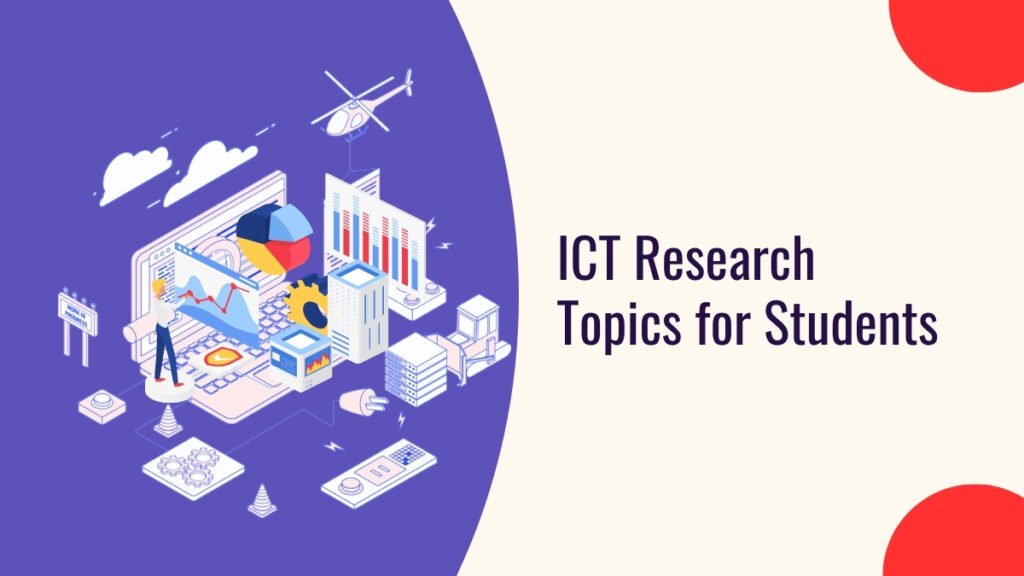Discover exciting STEM research topics that inspire creativity and innovation. Explore ideas in science, technology, engineering, and math to boost your learning and research projects.
Have you ever wondered how the technology we rely on daily was developed? What drives scientists to uncover the mysteries of our universe? How do engineers create innovative solutions for real-world problems?
These questions highlight the significance of STEM education—science, technology, engineering, and mathematics—in today’s rapidly changing world. STEM is not just a set of subjects; it is a vital framework that equips students with the skills and knowledge needed to thrive in a competitive global landscape.
As industries evolve and new challenges arise, the importance of a strong foundation in STEM cannot be overstated. From advancing healthcare to tackling climate change, STEM fields offer opportunities for creativity, innovation, and societal impact.
This article will explore the essential role of STEM education, its benefits for high school students, popular research areas, project ideas, and tips for engaging with the community and pursuing research.
Stem Research Topics PDF
Importance of STEM in Today’s World
In our increasingly interconnected world, the role of STEM has become more critical than ever. The challenges we face—whether environmental, technological, or societal—require innovative solutions and a skilled workforce.
STEM education fosters an understanding of complex systems and prepares students to approach problems analytically. As economies shift towards knowledge-based industries, proficiency in STEM fields becomes essential for individual career success and national competitiveness.
The integration of technology in everyday life further underscores the need for STEM literacy. From artificial intelligence to renewable energy, understanding the principles of science and mathematics empowers individuals to make informed decisions and contribute to discussions on vital issues.
Moreover, as globalization continues to blur geographical boundaries, collaboration across disciplines and cultures becomes crucial. STEM education not only cultivates technical skills but also enhances collaboration and communication—key competencies in the 21st century.
Overview of STEM Fields
STEM encompasses a wide range of disciplines that contribute to the advancement of society. Each field plays a unique role in fostering innovation and addressing contemporary challenges:
Science
The foundation of understanding the natural world, science encompasses various disciplines such as biology, chemistry, and physics. Scientists investigate the mechanisms of life, matter, and energy, providing essential knowledge for advancements in health, technology, and environmental sustainability.
Technology
This field focuses on the application of scientific knowledge for practical purposes. From computer programming to information technology, technological innovations shape industries and enhance our daily lives.
Engineering
Engineers design, build, and maintain systems and structures, applying principles of mathematics and science to create solutions for real-world problems. Engineering disciplines include civil, mechanical, electrical, and aerospace, each contributing to infrastructure, transportation, and technology.
Mathematics
Often considered the backbone of STEM, mathematics provides the tools for analysis, modeling, and problem-solving across all scientific and engineering fields. It plays a critical role in data analysis, statistical research, and theoretical foundations.
Benefits of STEM Research for High School Students
Engaging in STEM research offers numerous benefits for high school students, equipping them with essential skills for future success.
Developing Critical Thinking Skills
STEM research encourages students to think critically and question assumptions. By designing experiments or solving complex problems, students learn to analyze information, evaluate evidence, and draw logical conclusions. This skill set is invaluable in all aspects of life, from academic pursuits to personal decision-making.
Enhancing Problem-Solving Abilities
In STEM research, students confront real-world challenges that require innovative solutions. This hands-on experience promotes resilience and adaptability, teaching students to approach problems systematically and creatively. As they navigate setbacks and refine their strategies, they develop perseverance—a trait that serves them well in any endeavor.
Encouraging Innovation and Creativity
STEM research is inherently exploratory, inviting students to think outside the box. Whether they are developing a new technology or exploring ecological solutions, students learn to approach challenges with an open mind and a willingness to experiment. This environment nurtures creativity, preparing them for roles in an ever-evolving job market that values innovative thinkers.
Popular STEM Research Areas
High school students have access to a variety of exciting STEM research areas. Here are a few popular ones:
Biology and Environmental Science
Climate Change and Sustainability: Students can investigate the effects of climate change on local ecosystems, explore renewable energy options, or develop strategies for reducing carbon footprints.
Biodiversity and Ecosystems: Research can focus on local flora and fauna, examining their roles within ecosystems and the impacts of human activity on biodiversity.
Chemistry
Renewable Energy Sources: Students can explore chemical processes involved in biofuels or solar energy, learning about sustainable alternatives to fossil fuels.
Chemical Reactions in Everyday Life: Experiments involving household chemicals can help students understand the chemistry behind cooking, cleaning, and other daily activities.
Physics
Renewable Energy Technologies: Students can study the physics behind solar panels, wind turbines, or energy efficiency, contributing to the dialogue on sustainable energy.
The Physics of Sports: Researching the mechanics of athletic performance can lead to insights on training techniques, equipment design, and injury prevention.
Mathematics
Data Analysis and Statistics: Students can engage in projects that analyze real-world data, learning to interpret trends and make predictions.
Mathematical Modeling in Real-World Scenarios: By developing models to represent complex systems, students can explore applications in fields like economics, biology, and engineering.
179+ Innovative Stem Research Topics
Engaging in STEM research topics is an excellent way for students to apply their knowledge and skills. Here are a few innovative project ideas:
Biology
- Effects of plastic waste on ocean animals.
- Benefits and risks of genetically modified crops.
- The importance of bacteria in our digestive system.
- How climate change affects plant growth.
- Why biodiversity matters for our planet.
- What CRISPR can do for gene editing.
- How antibiotics affect good bacteria.
- Why bees are important for food.
- How aging affects our cells.
- The role of microbes in soil health.
Chemistry
- Chemicals in everyday cleaning products.
- Best ways to clean dirty water.
- What catalysts do in chemical reactions.
- Eco-friendly practices in chemistry.
- How baking ingredients interact.
- Effects of acid rain on plants.
- Analyzing biofuels as a renewable energy source.
- How food preservation works.
- Impact of heavy metals on water.
- Exploring tiny materials (nanomaterials).
Physics
- Comparing solar and wind energy.
- Forces at play on roller coasters.
- How gravity affects different objects.
- What superconductors are and their uses.
- The science of sound in different spaces.
- How temperature affects electrical resistance.
- Physics behind sports movements.
- How friction affects motion.
- Light as both a wave and a particle.
- Building a simple motor with magnets.
Environmental Science
- How effective are recycling methods?
- Why urban trees are important.
- Impact of cutting down forests on wildlife.
- Ways to save water at home.
- How pollution affects local animals.
- Sustainable farming methods.
- Benefits of composting for soil.
- How climate change changes weather.
- How renewable energy sources work.
- Ways to lower our carbon footprints.
Computer Science
- Basics of coding with simple apps.
- Effects of AI on daily life.
- Importance of data privacy online.
- How algorithms shape our choices.
- Making a simple game with Scratch.
- Ethics of using AI technology.
- What blockchain is and how it works.
- Creating a website for a project.
- Future possibilities of quantum computers.
- Effects of social media algorithms.
Mathematics
- Exploring fractals and their uses.
- Statistics in sports performance.
- Math concepts in music.
- Real-life applications of probability.
- Fibonacci sequence in nature.
- Modeling population growth with math.
- Basics of coding and cryptography.
- Analyzing weather patterns using data.
- Geometry in art and design.
- Importance of math skills in everyday life.
Engineering
- Building a bridge with limited materials.
- How wind turbines generate energy.
- Basics of 3D printing.
- Designing a solar oven.
- Smart homes and their features.
- Choosing building materials: strength vs. cost.
- Creating a water filtration system.
- Role of engineering in emergencies.
- Effects of transportation on city planning.
- Developing an app for energy savings.
Astronomy
- Life cycle of stars and their significance.
- How we find planets outside our solar system.
- Role of black holes in galaxies.
- Effects of light pollution on stargazing.
- Basics of the Big Bang theory.
- Searching for alien life.
- Dangers of space debris for satellites.
- Future of space missions to Mars.
- Studying different celestial bodies.
- Importance of telescopes in astronomy.
Health Sciences
- Nutrition’s impact on mental health.
- How effective are vaccines?
- Exercise’s effect on school performance.
- Mental health resources for students.
- Importance of sleep for health.
- Spread of infectious diseases.
- How stress affects health.
- Alternative medicine practices.
- Tech’s role in healthcare.
- Effects of social media on body image.
Psychology
- How music influences mood.
- The psychology of colors.
- Social interactions and mental health.
- Understanding decision-making biases.
- Effects of screen time on youth.
- Psychology behind addiction.
- How psychology is used in marketing.
- Peer pressure effects on teens.
- What makes people happy.
- Effects of childhood trauma on adults.
Social Science
- Tech’s influence on social interactions.
- Education’s impact on job opportunities.
- Globalization’s effect on local cultures.
- Crime rates and community resources.
- Government’s role in environmental care.
- Media’s influence on public opinion.
- Importance of civic engagement.
- Immigration’s impact on economies.
- Social movements and change.
- Poverty’s effect on education.
Robotics
- Building a basic robot.
- Ethics of robots in society.
- Future of self-driving cars.
- Robots in healthcare.
- Designing a robot for a task.
- Robotics’ impact on jobs.
- Using drones in various fields.
- Robotics in education.
- AI and robotics together.
- Making a robot that solves a maze.
Interdisciplinary
- How biology inspires engineering (biomimicry).
- Tech’s role in protecting the environment.
- Social effects of scientific discoveries.
- Climate change and human health.
- Economics and environmental science connections.
- How culture influences research.
- Importance of communication in science.
- Education’s effect on health.
- Ethics in genetic engineering.
- Tech and privacy concerns.
Specific Projects
- Surveying local recycling habits.
- Creating a community garden.
- Making an app for healthy eating.
- Testing water quality in your area.
- Building a small wind turbine.
- Analyzing school lunch nutrition.
- Starting a campaign on climate change.
- Experiments on how plants grow in different lights.
- Creating a documentary about local issues.
- Studying local wildlife habitats.
More Topics
- Investigating local wildlife.
- Effects of fertilizers on plant growth.
- Evaluating local recycling programs.
- Tech in emergency planning.
- Benefits of meditation for students.
- Fast fashion’s impact on the environment.
- Importance of wetlands.
- Sleep patterns and school performance.
- Renewable energy ideas for schools.
- Food deserts and community health.
Even More Ideas
- How tech changes relationships.
- Diet’s effect on sports performance.
- Exercise and mental health connections.
- Nutrition’s role in child growth.
- Sedentary lifestyle impacts.
- Study techniques and their effectiveness.
- Local air quality and health.
- Food deserts and health issues.
- Science behind popular diets.
- Community health initiatives and their success.
STEM and Society
- Role of policies in research.
- Media’s effect on science understanding.
- Community health programs: are they working?
- Importance of scientific knowledge in democracy.
- Tech in social movements.
- Education and economic growth.
- Global health issues in local areas.
- Effects of social inequality on learning.
- Youth in environmental action.
- Tech’s impact on job availability.
Additional Interdisciplinary Topics
- Art and technology connections.
- Digital marketing effects on consumers.
- Science in politics.
- The impact of social media on activism.
- Exploring culture and health connections.
- Technology in education: benefits and challenges.
- Climate change: global vs. local impacts.
- Using math to solve real-life problems.
- The influence of public health on community well-being.
- Gender differences in STEM fields.
Tips for Choosing the Right Research Topic
Selecting a research topic is a crucial step in the STEM journey. Here are some tips to help students make informed choices:
Aligning Interests with Real-World Issues
Students should consider their passions and how they align with pressing global challenges. Researching topics that resonate personally will increase motivation and engagement.
Considering Available Resources and Mentorship
Identifying available resources—such as lab equipment, technology, or community organizations—can significantly impact project feasibility. Additionally, seeking mentorship from teachers or professionals in the field can provide guidance and support.
Engaging with the Community: Real-World Applications
Connecting STEM research to the community enhances its relevance and impact. Here are ways students can engage:
Collaborating with Local Organizations
Partnering with local organizations can provide students with valuable resources and insights. Whether it’s a university, environmental group, or tech company, collaboration enriches the research experience.
Participating in Science Fairs and Competitions
Science fairs and competitions allow students to showcase their work, receive feedback, and connect with peers. These events foster a sense of community and encourage a spirit of inquiry.
Resources for STEM Research
Numerous resources are available to support students in their STEM research endeavors:
Online Databases and Journals
Access to scientific journals and databases enables students to stay informed about the latest research and trends in their fields of interest.
Books and Publications
Books on specific STEM topics can provide foundational knowledge and inspire students with case studies and practical examples.
Local STEM Clubs and Organizations
Joining local STEM clubs or organizations offers opportunities for networking, collaboration, and skill development through workshops and events.
Encouraging Lifelong Learning
STEM education fosters a mindset of lifelong learning. As technology and knowledge evolve, staying curious and engaged with new developments is essential. Students who cultivate this mindset will be better prepared to adapt to future changes and contribute to their fields.
The Role of Students in Shaping Tomorrow’s Innovations
High school students are not just passive learners; they are active contributors to the innovation landscape. Through their research and projects, they can influence local communities and inspire future generations. By embracing their potential and pursuing STEM, they can help shape a better world.
How to Get Started on Your STEM Journey?
Beginning a STEM journey can be daunting, but there are simple steps to take:
- Identify Your Interests: Reflect on subjects that fascinate you and consider how they relate to real-world issues.
- Seek Resources: Utilize available resources such as books, online courses, and community organizations to build your knowledge base.
- Engage with Mentors: Reach out to teachers, professionals, or peers who can provide guidance and support.
- Start Small: Begin with manageable projects to build confidence and skills before tackling larger research endeavors.
Wrap Up: The Future of STEM Research
As we look to the future, the importance of STEM education continues to grow. The challenges facing our world—be it climate change, public health crises, or technological advancements—demand innovative solutions and a skilled workforce.
By investing in STEM education, we equip the next generation with the tools to understand and tackle these issues. High school students, with their fresh perspectives and creativity, have the potential to drive meaningful change through research and innovation.
As they embark on their STEM journeys, they not only enhance their own futures but also contribute to a brighter, more sustainable world for all. Embracing the spirit of inquiry and collaboration, today’s students will undoubtedly shape the innovations of tomorrow.



